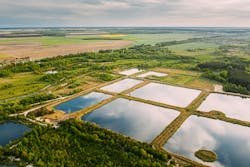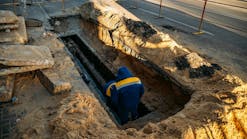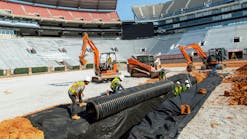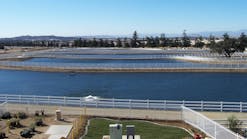Creating your first MS4 plan? Start here.
Sewer systems that discharge untreated stormwater, also known as Municipal Separate Storm Sewer Systems (MS4s), must obtain a National Pollutant Discharge Elimination System permit. This requirement was put into place by the Clean Water Act of 19721 to protect and improve the water quality of our lakes, rivers and streams. There are approximately 7,550 permitted MS4s throughout the United States, according to the U.S. Environmental Protection Agency (EPA)2. Permit requirements vary among MS4s based on factors that include the size of the population served and the state in which the MS4 is located. While some states require MS4s to reduce stormwater pollution to certain target levels, each state has its own requirements and targets. When is an MS4 Plan Necessary? There are six minimum control measures all MS4 permittees must comply with: Public Education and Outreach, Public Involvement, Illicit Discharge Detection and Elimination, Construction Site Runoff, Post-Construction Runoff, and Good Housekeeping.
Beyond the minimum control measures, permit requirements vary based on whether an MS4 is categorized as Phase I (those serving populations of 100,000 or more), or Phase II (those MS4s serving populations of 10,000 to 99,999). Phase I permittees are subject to an additional monitoring requirement.
Some states also require MS4s to reduce stormwater pollution from their developed urban area. In these cases, each MS4 is given a target via their permit — e.g., 40% reduction of total suspended solids3 or treatment of 20% of the existing impervious area4 — and must develop plans to achieve these targets. Once the plans are complete, MS4s implement stormwater control measures (SCMs) to remove pollution from their existing systems. As state regulations evolve, MS4s may need to develop and implement new plans to remain compliant. If you are an MS4 manager without this kind of stormwater planning experience, this may seem daunting at first — but remember: you are not alone! There are plenty of best practices and precedents to draw from.
Developing your MS4 plan
When developing or amending Stormwater Quality Management Plans, it can be helpful to think in terms of the “Five W’s and One H” — Who, What, When, Where, Why, and How? The answers to these questions below can help you formulate and refine your plan.
Who (there are a few of these):
- Who is going to manage the plan’s development? It is important to designate a project manager who can oversee plan development, understand the plan’s timeline (dictated by the permit), and when needed, bring necessary stakeholders together.
- Who is going to approve the plan? Thinking through the approval process will help you tailor your plan to the correct audience. Potential plan approvers may include your municipal board or council, your state regulatory agency, the EPA, the public, co-permittees and others.
- Who is going to implement the plan? Retrofitting an urban area may require involvement from several different agencies and stakeholders. The person(s) implementing the plan should be able to coordinate and facilitate these interactions. For example, construction of sustainable infrastructure in a city street may require involvement from the local transportation agency. Or, if a stormwater control measure is to be implemented within the boundaries of a park, the local park agency may be a stakeholder.
What are the permit targets?
The MS4 permit will define the pollution reduction targets.
When (this typically has two parts):
- When is the plan due to the regulatory agency? The MS4 permit will include due dates. Plans take one to two years to develop. As such, the planning should begin at least two years prior to the due date to ensure the plan can go through the appropriate approvals.
- When do the targets need to be met? The permit will indicate target deadlines. The plan should include an implementation schedule to meet the permitted timeline. The implementation schedule is comprised of a list of projects and their associated pollution reduction capacity. All the projects should be implemented prior to the permit deadline.
Sometimes, there can be roadblocks to meeting these timelines. Project implementation cost is one example. Additionally, in some areas, available stormwater technology has not caught up to aggressive targets (e.g., 89% total phosphorus reduction). When facing situations like these, the MS4 manager should meet with the regulatory agency and try to negotiate a longer permit implementation schedule.
Where should the plan be implemented?
In most cases, this is the developed urban area as defined by the most recent United States Census. If your MS4 is contained within a single jurisdiction, then your “where” is simply that designated census area. While this is typically straightforward, it may be more complicated if your MS4 is interwoven with other MS4s.
As an example, a county with an MS4 permit that has one or more MS4 permitted cities within its borders, requires extra effort to define their MS4 area. In these scenarios, entities that own part of an MS4 may not be the same entities that maintain it. One example is a county highway that runs through a designated city, for instance. The county may own the MS4 infrastructure, but they contract with the city to maintain it.
In these situations, the best practice is to arrange meetings with the applicable agencies and establish who will take responsibility for the MS4, and thus who will be responsible for the pollutionloading from it. Preparation for these meetings should include the creation of maps showing ownership, operation and maintenance assignments.
Why is the plan being developed?
The “why” is a regulatory requirement with the purpose of improving the quality of our local lakes, rivers and streams.
How will the plan be developed and implemented?
The components of the plan should include:
- Data Collection. Information describing and quantifying the MS4 system and the land that drains to it. This will include GIS data such as: land use, storm sewers and ditches, existing SCM locations and topography. This will also include stormwater management plans for new and existing development, construction drawings of public SCMs, and the current schedule for catch basin sump cleaning and street cleaning.
- Analysis. The analysis should quantify the existing pollution loading and the amount of loading that needs to be removed to meet the targets. Hot spots (locations generating more pollution) should be identified as priority areas.
- Proposed SCMs. Once the analysis is complete, proposed SCMs should be conceptually sized to remove the targeted amount of pollution. Allowable SCMs and credit vary by state. Refer to the state’s guidance on allowable SCMs.
- Implementation Schedule. Following development of the proposed SCMs, a schedule of implementation (including design, permitting and construction) should be created that meets permit requirements.
- Next Steps. Finally, the plan should include a list of the next steps. These steps include the approvals process, adding the Proposed SCM projects to the Capital Improvement Program, and investigating funding opportunities.
Your plan should be tailored, realistic and actionable!
Each MS4 is unique and requires a tailored plan that considers and addresses specific factors. If you are considering hiring a consultant to help with your MS4 plan development, it is critical that they have a wide array of experience and good familiarity with developing tailored plans addressing unique challenges and factors. You can use the information from the questions above to help you write an informative request for proposal, to guide your consultant, and to develop a realistic and implementable plan that helps your MS4 comply with its permit requirements.
References
- https://www.epa.gov/laws-regulations/summaryclean- water-act#:~:text=33%20U.S.C.%20 %C2%A71251%20et,quality%20standards%20for%20 surface%20waters.
- https://www.epa.gov/npdes/stormwaterdischarges- municipal-sources
- https://dnr.wisconsin.gov/topic/Stormwater/ municipal/overview.html
- https://mde.maryland.gov/programs/water/ stormwatermanagementprogram/pages/storm_ gen_permit.aspx
Caroline Burger
Caroline Burger has 22 years of experience working with public and private clients. Her expertise includes urban hydrologic, hydraulic- and nonpoint-source pollution modeling and design, stormwater utility development, and program management. Burger is also a partner in PV & Associates and helps to develop the urban water quality model WinSLAMM. Burger can be reached at [email protected].








